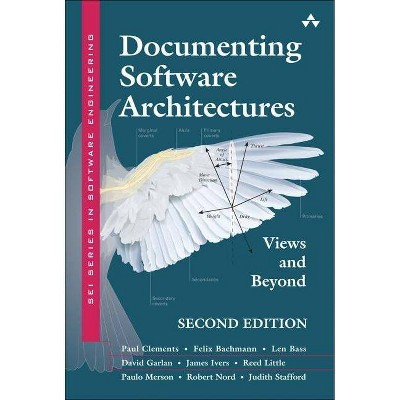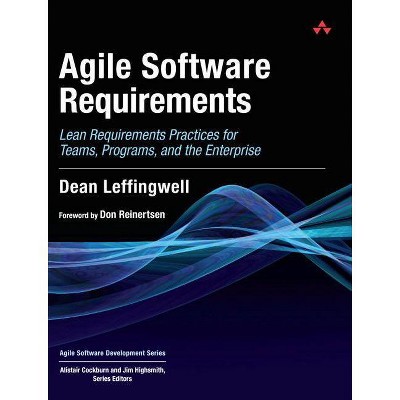Documenting Software Architectures - (SEI Software Engineering) 2nd Edition (Hardcover)

Similar Products
Products of same category from the store
AllProduct info
<p/><br></br><p><b> About the Book </b></p></br></br>Software architecture--the conceptual glue that holds every phase of a project together for its many stakeholders--is widely recognised as a critical element in modern software development. Practitioners have increasingly discovered that close attention to a software system's architecture pays valuable dividends. Without an architecture that is appropriate for the problem being solved, a project will stumble along or, most likely, fail. Even with a superb architecture, if that architecture is not well understood or well communicated the project is unlikely to succeed. <p/> <strong><em>Documenting Software Architectures</em></strong> provides the most complete and current guidance, independent of language or notation, on how to capture an architecture in a commonly understandable form. Drawing on their extensive experience, the authors first help you decide what information to document, and then, with guidelines and examples (in various notations, including UML), show you how to express an architecture so that others can successfully build, use, and maintain a system from it. The book features rules for sound documentation, the goals and strategies of documentation, architectural views and styles, documentation for software interfaces and software behaviour, and templates for capturing and organising information to generate a coherent package.<p/><br></br><p><b> Book Synopsis </b></p></br></br><i>"This new edition is brighter, shinier, more complete, more pragmatic, more focused than the previous one, and I wouldn't have thought it possible to improve on the original. As the field of software architecture has grown over these past decades, there is much more to be said, much more that we know, and much more that we can reflect upon of what's worked and what hasn't--and the authors here do all that, and more."</i> --From the Foreword by Grady Booch, IBM Fellow</p> </p> Software architecture--the conceptual glue that holds every phase of a project together for its many stakeholders--is widely recognized as a critical element in modern software development. Practitioners have increasingly discovered that close attention to a software system's architecture pays valuable dividends. Without an architecture that is appropriate for the problem being solved, a project will stumble along or, most likely, fail. Even with a superb architecture, if that architecture is not well understood or well communicated the project is unlikely to succeed.</p> </p> <b><i>Documenting Software Architectures, Second Edition, </i></b> provides the most complete and current guidance, independent of language or notation, on how to capture an architecture in a commonly understandable form. Drawing on their extensive experience, the authors first help you decide what information to document, and then, with guidelines and examples (in various notations, including UML), show you how to express an architecture so that others can successfully build, use, and maintain a system from it. The book features rules for sound documentation, the goals and strategies of documentation, architectural views and styles, documentation for software interfaces and software behavior, and templates for capturing and organizing information to generate a coherent package. New and improved in this second edition: </p> </p> <ul> <li>Coverage of architectural styles such as service-oriented architectures, multi-tier architectures, and data models</li> <li>Guidance for documentation in an Agile development environment</li> <li>Deeper treatment of documentation of rationale, reflecting best industrial practices</li> <li>Improved templates, reflecting years of use and feedback, and more documentation layout options</li> <li>A new, comprehensive example (available online), featuring documentation of a Web-based service-oriented system</li> <li>Reference guides for three important architecture documentation languages: UML, AADL, and SySML</li> </ul><p/><br></br><p><b> From the Back Cover </b></p></br></br><i>"This new edition is brighter, shinier, more complete, more pragmatic, more focused than the previous one, and I wouldn't have thought it possible to improve on the original. As the field of software architecture has grown over these past decades, there is much more to be said, much more that we know, and much more that we can reflect upon of what's worked and what hasn't--and the authors here do all that, and more."</i> <p>--From the Foreword by Grady Booch, IBM Fellow</p> <p> </p>Software architecture--the conceptual glue that holds every phase of a project together for its many stakeholders--is widely recognized as a critical element in modern software development. Practitioners have increasingly discovered that close attention to a software system's architecture pays valuable dividends. Without an architecture that is appropriate for the problem being solved, a project will stumble along or, most likely, fail. Even with a superb architecture, if that architecture is not well understood or well communicated the project is unlikely to succeed. <p> </p> <p><b><i>Documenting Software Architectures, Second Edition, </i></b> provides the most complete and current guidance, independent of language or notation, on how to capture an architecture in a commonly understandable form. Drawing on their extensive experience, the authors first help you decide what information to document, and then, with guidelines and examples (in various notations, including UML), show you how to express an architecture so that others can successfully build, use, and maintain a system from it. The book features rules for sound documentation, the goals and strategies of documentation, architectural views and styles, documentation for software interfaces and software behavior, and templates for capturing and organizing information to generate a coherent package. New and improved in this second edition: </p> <p> </p> <ul> <li>Coverage of architectural styles such as service-oriented architectures, multi-tier architectures, and data models </li> <li>Guidance for documentation in an Agile development environment </li> <li>Deeper treatment of documentation of rationale, reflecting best industrial practices </li> <li>Improved templates, reflecting years of use and feedback, and more documentation layout options </li> <li>A new, comprehensive example (available online), featuring documentation of a Web-based service-oriented system </li> <li>Reference guides for three important architecture documentation languages: UML, AADL, and SySML</li> </ul><p/><br></br><p><b> About the Author </b></p></br></br><b>Paul Clements </b>is a Senior Member of the Technical Staff at the Carnegie Mellon Software Engineering Institute (SEI), where he has worked since 1994 leading or coleading projects in software product-line engineering and software architecture documentation and analysis. Besides this one, Clements is the coauthor of two other practitioner-oriented books about software architecture: <i>Software Architecture in Practice </i>(Addison-Wesley, 1998; Second Edition 2003) and <i>Evaluating Software Architectures: Methods and Case Studies </i>(Addison-Wesley, 2001). He also cowrote <i>Software Product Lines: Practices and Patterns </i>(Addison-Wesley, 2001) and was coauthor and editor of <i>Constructing Superior Software </i>(Sams, 1999). In addition, Clements has authored dozens of papers in software engineering, reflecting his longstanding interest in the design and specification of challenging software systems. In 2005 and 2006 he spent a year as a visiting faculty member at the Indian Institute of Technology in Mumbai. He received a Ph.D. in computer sciences from the University of Texas at Austin in 1994. He is a founding member of the IFIP Working Group on Software Architecture (WG2.10). <b> </b></p> <b>Felix Bachmann </b>is a Senior Member of the Technical Staff at the SEI, working in the Architecture Centric Engineering Initiative. He is coauthor of the Attribute-Driven Design Method, a contributor to and instructor for the ATAM Evaluator Training course, and a contributor to the book <i>Software Architecture in Practice, Second Edition</i>. Before joining the SEI, he was a software engineer at Robert Bosch GmbH in corporate research, where he worked with software development departments to address the issues of software engineering in small and large embedded systems.</p> </p> <b>Len Bass </b>is a Senior Member of the Technical Staff at the SEI. He has coauthored two award-winning books in software architecture as well as several other books and numerous papers in a wide variety of areas of computer science and software engineering. He has been a keynote speaker or a distinguished lecturer on six continents. He is currently working on applying the concepts of ultra-large-scale systems to the smart grid. He has been involved in the development of numerous different production or research software systems, ranging from operating systems to database management systems to automotive systems. He is a member of the IFIP Working Group on Software Architecture (WG2.10).</p> <b> </b></p> <b>David Garlan </b>is a Professor of Computer Science and Director of Software Engineering Professional Programs in the School of Computer Science at Carnegie Mellon University (CMU). He received his Ph.D. from CMU in 1987 and worked as a software architect in industry between 1987 and 1990. His interests include software architecture, self-adaptive systems, formal methods, and cyber-physical systems. He is considered to be one of the founders of the field of software architecture and, in particular, formal representation and analysis of architectural designs. In 2005 he received a Stevens Award Citation for fundamental contributions to the development and understanding of software architecture as a discipline in software engineering.</p> <b> </b></p> <b>James Ivers </b>is a Senior Member of the Technical Staff at the SEI, where he works in the areas of software architecture and program analysis. He received a Master of Software Engineering from CMU in 1996 and has worked for and with a variety of development organizations, from start-up to multinational corporations. He has written numerous papers, contributed to the development of an international standard for distributed simulations, and has recently been working in a public-private c</p>
Price History
Cheapest price in the interval: 69.99 on November 6, 2021
Most expensive price in the interval: 69.99 on February 4, 2022
Price Archive shows prices from various stores, lets you see history and find the cheapest. There is no actual sale on the website. For all support, inquiry and suggestion messages communication@pricearchive.us




















